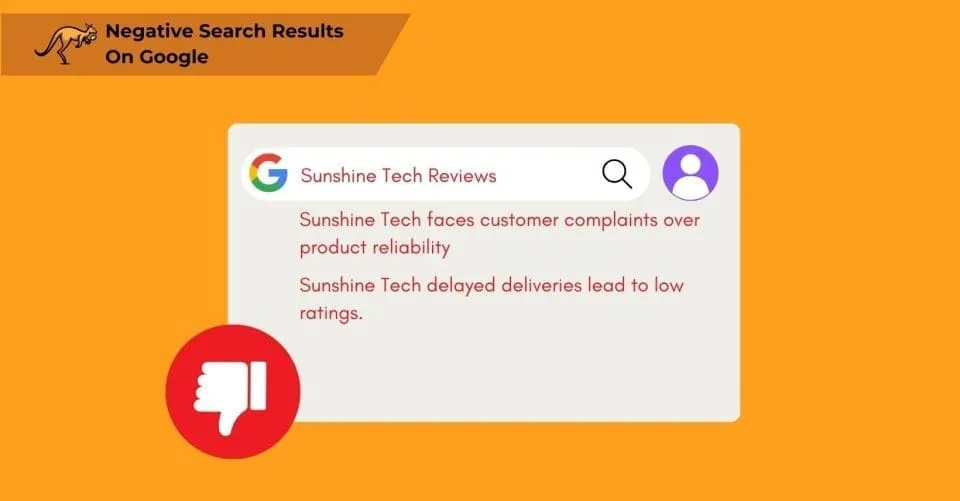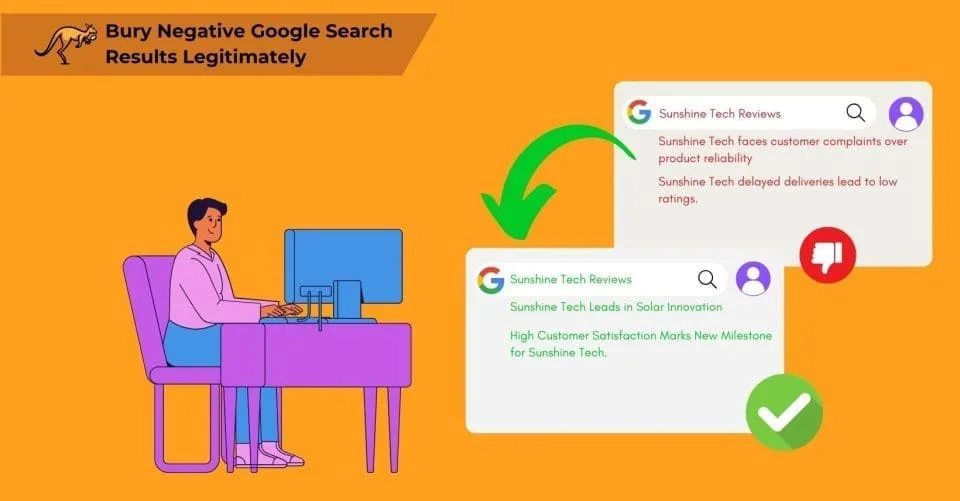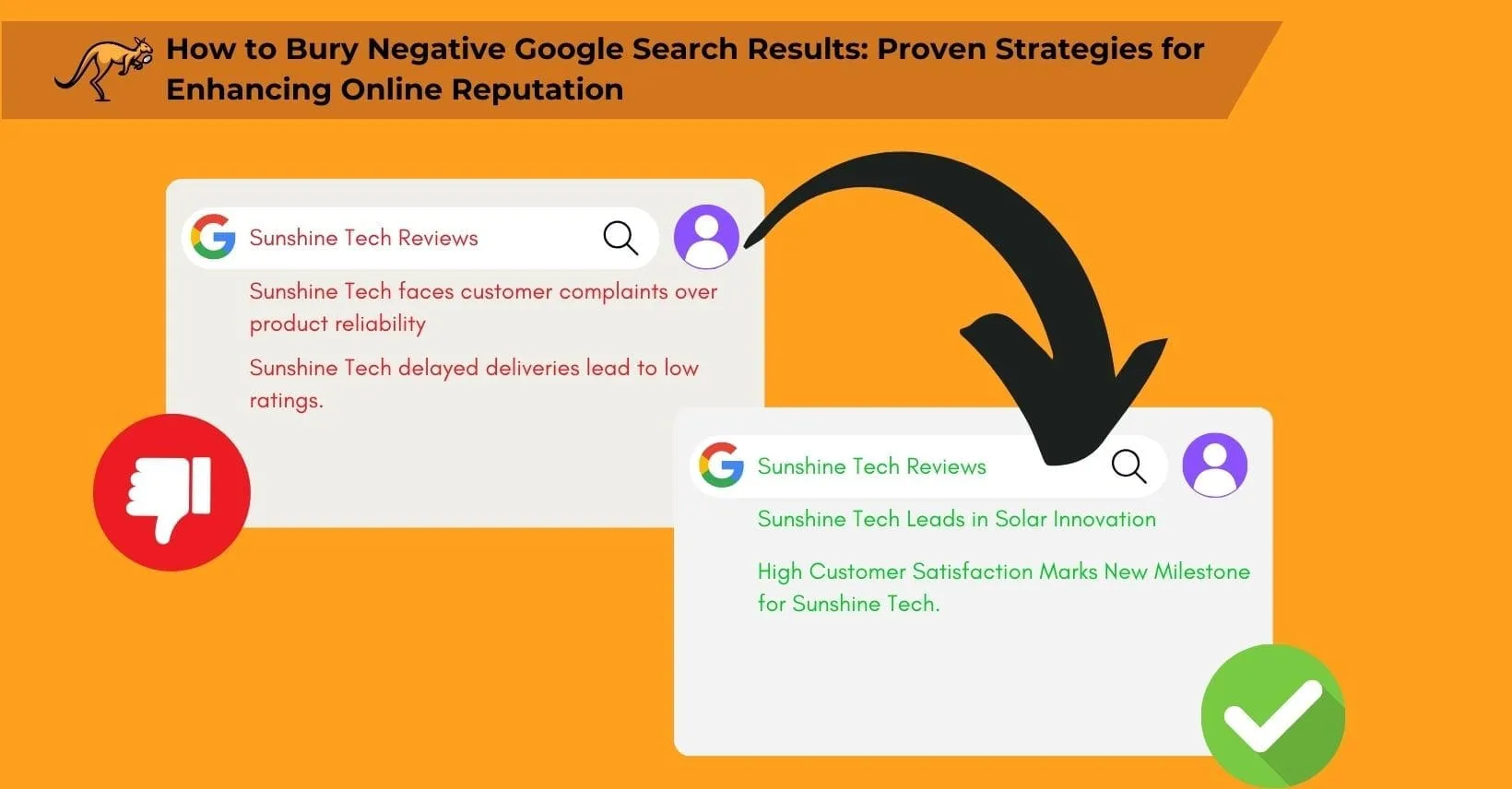It is easy to follow the famous quote that “all press is good press”, but that is not always the case when it comes to digital marketing.
Whether it is a bad review or an article complaining regarding your brand, negative results relating to your business can be a huge problem.
If users are getting negative search results when they look up your business, then your reputation and customer base can be on the line.
One practical and feasible approach to mitigating the impact of undesirable content is to bury negative search results on Google. This proactive strategy involves pushing down harmful links that could potentially damage your reputation. But how feasible is this tactic?
This leads us to explore the nature of these unfavourable listings further. Next, we will explore what negative search results on Google entail, providing a foundation for strategies to manage or suppress them effectively.
What are Negative Search Results On Google?

Negative search results on Google are unfavorable content that damages your brand reputation, which includes negative articles, bad reviews, or complaints about your business that appear when users search for your brand name or related terms.
While most of this negative stuff will be buried in the second or third pages (if not lower), there is always a chance that negative content could climb onto the first page.
Negative search results have a chance to harm your business’s reputation and damage your sales, something that can become a huge problem if you are barely keeping yourself afloat anyway.
The visibility of the top three spots on Google’s first results page is critical for digital marketing, yet negative content in these positions can severely damage a brand’s image.
Since users rarely venture beyond the first few search results, negative entries can monopolize important marketing space, presenting an unwelcome challenge.
However, effective online reputation management strategies can significantly mitigate this impact, provided you employ the right techniques. Transitioning from understanding the problem to solving it, we now explore legitimate methods to bury negative Google search results, ensuring your brand maintains its valued online presence.
How to Bury Negative Google Search Results Legitimately

You can legitimately bury negative Google search results by employing white hat SEO techniques that focus on creating high-quality content, optimizing existing web assets, and building authoritative profiles across multiple platforms rather than using black hat methods that might cause greater problems.
You need to remove the negative result in a way that leaves no lingering problems or after-effects.
In general, there are two core ways to deal with negative content releases and articles: removing them or suppressing them by burying them further back in your search results.
The first of these, removal, is the fastest option – but this will not always work.
How to Remove Negative Search Results
Removing an unwanted search result can be done in a few ways, which you usually need to do in sequence.
This is because Google (and other search engines) really do not want people abusing their system and often require proof that you have attempted to take the content down in other ways.
Content Removal Requests
You can advise a site to remove content if it violates either Google’s guidelines or the site’s guidelines. For example, many review sites do not allow reviews to include the full names of employees, which would be grounds for getting a review pulled.
You can also remove copyrighted content or any content that is not legal to publish (such as information gained after signing a Non-Disclosure Agreement.
Requesting Content Removal From Google
If the site owners (or whoever wrote/posted the content) will not remove it despite there being grounds for its removal, you can request that Google remove the page from its search algorithm.
Google cannot guarantee that the content itself is removed, but it will no longer appear in search results. This effectively prevents it from appearing when people are searching for your brand, but the article still exists.
Contact The Author
Reaching out to content authors occasionally facilitates the removal of outdated or inaccurate negative reviews, especially if the review is no longer relevant to your current offerings. However, cooperation from authors is only sometimes guaranteed. Presenting evidence of inaccuracies persuades some, but others remain unresponsive or retain biases against your brand.
This outcome variability highlights the need for a more controlled approach to mitigating negative search results. Thus, it becomes essential to explore additional strategies that can effectively suppress such results, ensuring your digital footprint accurately reflects your brand.
Now, let’s delve into effective techniques for suppressing negative search results, which will provide a clearer pathway to safeguarding and enhancing your online reputation.
How to Suppress Negative Search Results
If removal attempts fail, you can suppress negative search results on Google by creating better content than the negative material, optimizing your website with relevant keywords, and developing a network of high-authority pages that outrank the unfavorable content in search rankings.
This might seem like a more underhanded method, but it is actually entirely white hat and simply relies on you creating better content than the negative content.
The most important factor here is your content’s relevancy and quality – the former relies on keywords, and the latter relies on things like domain authority and your backlink profile.
Publishing articles praising your services isn’t enough to counteract negative search results. To effectively diminish the visibility of detrimental content, you must strategically create and rank higher-quality content.
This approach pushes down negative press releases and articles in search results, gradually making them less visible. By elevating positive content, you ensure that unfavourable articles are displaced from the prominent pages of search results, thus safeguarding your brand’s online reputation.
This method of content ranking is important for controlling the narrative around your brand, leading us into the next section. Here, we will explore various tactics for suppressing negative search results, ensuring that your positive outreach dominates the digital landscape.
Keyword Research
Keyword research strategies for burying negative content begin with identifying all terms triggering the negative results, including your brand name plus product types or review-related phrases, which allows you to target these specific keyword combinations in your new content creation efforts.
Whether they are looking up “(company) reviews” or even something as simple as “(company) (product type),” there is always a chance that the addition of a new keyword could trigger the negative links to appear.
Say a furniture company gets bad news about one of their chairs injuring somebody. While this news might be hidden if you were to look up the company’s name, mentioning chairs in the search might be enough to nudge the negative article back into the search results.
Keyword checker tools and other SEO tools can be invaluable for finding out why negative content is appearing and then identifying a primary keyword and any other target keywords that might be linked to it.
Doing this is important since the target keyword set you find is vital to burying the bad press.
Using the same keywords in new content means that you are directly competing with the article you want gone, which means that you are already on track to overtake it in the rankings.
Prepare Keyword Tracking Tools
While you might find the keywords you need to bury negative search results, remember that SEO is always changing. Search engine results can be different only a few months after your initial search, so be sure to start using keyword-tracking tools if you are worried about articles resurfacing.
Depending on how prominent the bad content is, it can take effort to keep burying negative search results whenever they crawl back into your front page results. Do not just assume that the problem is dealt with initially, at least not in the long term.
Flooding Results Pages with Positive Links
You can flood search results pages with positive links by optimizing your website’s internal pages, creating profiles on high-authority social media platforms like LinkedIn and YouTube, setting up blogs with targeted content, and developing business apps that all rank for your brand name and related keywords.
If you want to push down negative search results, then you need more positive ones to overtake them – and that means that flooding relevant searches with other pages can really work.
The more space your own links and profiles occupy, the less space third-party reviews can take up. With the right combination of sites, this can make it very difficult for negative results to reach the front page.
Start Optimizing Your Site Links
One of the best features that Google offers is the added snippets that you can attach to links. These can be alternative pages, search bars that use your own site search feature, or even just a longer description based on existing content.
While you might not realize this at first, these actually impact search results. Having more content in your links can actually reduce the number of results that Google suggests, so beefier search result listings can actually help you push negative Google search results right back into the second page.
The same goes for adding brand names to your page titles and metadata. If somebody looks your business name up, Google wants to show pages with that name in them first – which usually just means your main page.
However, by including your brand name on as many pages as possible, you might start seeing existing content, such as your contact page, appearing underneath the main result for the site itself. Once again, this eats up space and makes it harder for bad content to rank easily.
Create Profiles on Social Media Sites
Social media profiles play a crucial role in burying negative content because these high-authority platforms rank prominently in search results, with profiles from sites like YouTube, LinkedIn, and Pinterest occupying valuable first-page positions that would otherwise potentially display negative content about your brand.
Again, since most social media accounts are going to use your business name, they will rank highly for your brand name. This saves you from having to make your own content since you can effectively just reuse existing assets to quickly set up profiles.
Even lesser-considered sites like Pinterest can be perfect for this. Pinterest has very little to do with most businesses, but it ranks so high that it can swallow up a space on the first page of results anyway.
Set Up a Blog
If your site does not already have a blog, it can be an incredibly fast way to fill the first page with even more links.
It only takes a little while to slightly rewrite some older content and use it as a basic blog post – and each individual piece of blog post content can be customized to meet your target keyword.
While this might not be all that effective, it can still be a good option for quickly pumping out a lot of specially prepared pages without much effort.
Create Business Apps
If you have the resources, creating apps is a good way to add more links to the front page. These take up yet another results slot, no matter how basic they are – and the more good reviews they get, the more likely they might be to rank.
This is another option that allows you to use the business’ name, meaning that you will probably get some extra priority when trying to link for all the right things.
Creating New Content

The types of new content you should create to push down negative results include targeted blog posts addressing your industry expertise, press releases highlighting company achievements, Wikipedia pages, personal employee testimonial sites, and content on respected platforms that Google prioritizes in search rankings.
New content can be custom-written to fit whatever keywords you need to target, meaning that you can take whatever steps are needed to push negative search results back.
Unlike simply optimizing existing content, this can also double as a way to push out more high-quality content that might improve your personal brand anyway.
By creating more content that falls into the right niches, you can weaken negative Google search results without having to actually engage with them directly – and the content you create will have a positive effect on your SEO overall.
Blog Posts
Creating blog content effectively suppresses negative results because each blog post targets specific keywords related to your brand, creates additional indexed pages that can rank for various search terms, improves your website’s overall SEO value, and provides opportunities to address topics related to the negative content without directly referencing it.
Beyond that, a good mix of branded keywords and other target keywords means that each blog post can appear for different topics across multiple searches, giving you a network of posts that can all work as specially prepared reputation management tools
Remember that good blog posts can also improve the user’s perceived value of your site and boost your Search Engine Optimization efforts, too.
This gives them a use beyond simply trying to suppress negative search results.
New Domains
Google likes to push sites with relevant domains into search results if it can, and that gives you another option to work with.
Buying the same domain across multiple TLDs (such as .uk, .net, .org, and so on) will let your site appear in multiple spots at once.
If these alternate domains are well-optimized and actually used for something, then you basically get another way to eat up search results space with very little effort.
Address Negative Content
One last resort is to address the negative content directly without linking to it. This denies the negative content any SEO benefits while also giving you a chance to directly address your online reputation.
This option is not always reliable, but it can be a good way to recapture a positive online reputation while also being able to remove negative search results from the top spot.
While addressing a controversy draws more attention to it, this can sometimes be worth it, depending on what the issue actually is.
For example, if a lot of the negative search result options are reviews of outdated products, publishing an article about what the new version gets right could be enough.
If you do this well, you might actually boost your positive online reputation among your audience just by addressing the negative results.
However, it is important to make it look like a move focused on being honest and direct rather than an effort to replace negative news with positive press.
Use Official or Respected platforms
The best platforms to use when trying to bury negative content include Wikipedia, Google My Business, major social media networks like LinkedIn and YouTube, press release distribution sites like Newswire and PRLog, industry directories, and software download sites that all have high domain authority and rank well in Google’s search results.
Google likes to promote informative content, so using platforms like Wikipedia to manage your online reputation and suppress negative search results is an entirely viable option.
Press Releases
There are various platforms, such as Newswire and PRLog, that exist primarily to let businesses host press releases.
This is another great tool for overwhelming negative results with positive information, this time written by your business itself.
Well-prepared press releases that are obviously positive in nature are ideal because these become positive search results that can hinder negative feedback.
For example, a press release regarding a positive result in an employee reward scheme can completely drown out a couple of negative reviews.
Personal Sites
Many people have a personal website (or even a personal brand site).
Simply linking to your online business from these sites can help a lot, especially if you have a page there that is exclusively regarding your work with that business.
This becomes a great online reputation management tool if you can get multiple employees or company members to do it since it basically allows you to cover the font page with personal pages regarding how much employees enjoy (or achieve) working under that brand.
Using Existing Assets
You can use existing assets to bury negative content by listing your software on trusted download sites, adding your business to relevant directories, splitting lengthy pages into multiple shorter ones with targeted keywords, and repurposing existing materials across different platforms to increase your digital footprint.
Doing this well can help you rank highly and make the entire process more efficient.
It does not even need to be high-quality content: all you need is something that can smother negative Google results with positive Google results.
Software
Putting software on trusted download sites is a good way to hide negative content associated with that software. As long as you are not putting it on scam sites, these software download sites can usually overtake negative search result pages.
Directories
Adding a listing to a directory can create a new set of search results that search engines will be willing to see as positive content, and a few might sneak onto the front page when users are looking for the right search terms.
Again, more space taken up by these pages means less space for negative content.
Separate Pages
Splitting lengthy pages into several shorter ones can enhance visibility on search engines. For instance, a detailed tutorial might be broken down into three or four sequential segments.
This strategy maintains a positive user experience and diversifies your content across multiple pages, each aligned with similar keywords and topics. Such segmentation gives search engines more options to feature your pages prominently, increasing your site’s footprint on relevant search result pages.
This method is particularly effective as burying negative search results by boosting the presence of positive content. The following section will delve deeper into how this approach can be systematically applied to enhance your online reputation.
Simple Guide to Burying Negative Search Results for Search Engine Optimization
Google search results can be fickle. One day, search engines might push down negative search results easily in favor of positive reviews, but a small change to those negative results can have them back on the first page again.
Proper Search Engine Optimization techniques – and, ideally, help from a real online reputation management company – are the best way to monitor and manage the search rankings of negative content.
Everything above was just an example of what to do and a detailed look at some of the techniques that you might choose to use.
Just in case, here is a short recap – along with some quick details on how to bury negative Google search results correctly.
Identify the Negative Result
To identify which negative results need to be addressed first, analyze which negative content appears highest in search rankings, determine which keywords trigger these results most frequently, and assess the potential damage each result could cause to your customer relationships or brand reputation.
Is it a bad review, or an angry blog post about a job candidate that was turned down, or a Twitter account post that somehow gained enough traction to appear as a search result whenever you type “(brand name) Twitter”?
Know what you are dealing with. Not all negative articles are the same, and you want to at least understand the basics of the situation.
In some cases, the review might be small enough that it does not really matter.
In other cases, you might need to seriously consider using professional reputation management services to deal with the problem. It all depends on how severe the issue is.
Know the Keywords
Both negative and positive search results rely on keywords in Google’s algorithm. Negative articles will not just appear at random – they will turn up when you put the right things in the search bar.
Finding the right keywords can give you actionable tips on how to approach the Google search results and how you can push down negative search results without having to constantly adapt the content until it works.
Remember that some keywords are stronger than others and that you need to consider how often a user is searching for them. The more likely they are to be used in a regular Google search, the more presence the bad content has.
Context matters: A user looking up “(brand) negative review” is obviously looking for bad reviews, but one looking for “(brand) contact page” is not.
Target the keywords that can do the most damage – meaning keywords that have the most impact on customers or visitors who do not know about the negative sentiment already.
Push Down Negative Search Results
The most important piece of advice is to actually start trying to push down negative content. It is easy to get hung up on things like exploring the Google search results keywords or trying to find positive reviews to boost with SEO, but you need to at least begin the process.
The sooner you can start to improve your Google search results, the better. It can take time for a negative search result to be overpowered by your SEO efforts, and the longer you leave that negative search result available, the more damage it can do.
It is important to get started as soon as you can, even if that means simple things like getting a free consultation from a reputation management company or gathering Google search data regarding your site and branding.
Sustaining Your SEO Efforts for Reputation Enhancement
You can sustain your SEO efforts for long-term reputation management by consistently gathering keyword data, monitoring search results with tracking tools, creating preemptive positive content, maintaining a dominant share of first-page results for your brand name, and regularly updating your content to maintain search relevance.
It also does not hurt to future-proof things by creating content ahead of time or making sure that you have a dominant share of the front page for your own brand name anyway.
Even if you have not seen any negative search results related to your business, it is a good idea to prepare yourself for the future. You never know when a disgruntled customer might post something that harms your reputation – which is especially bad if it is completely untrue.
Also, remember that some negative content can simply be removed through regular channels or by talking to the author directly. It doesn’t hurt to make an effort to resolve the problem that way before turning to more extreme methods.
Whatever you do, and however bad the content is for your brand, remember to think carefully regarding everything you do. Rushing into a solution could cause more problems than it solves, especially if you end up harming your SEO in the process of trying to take down a single Google search result.





